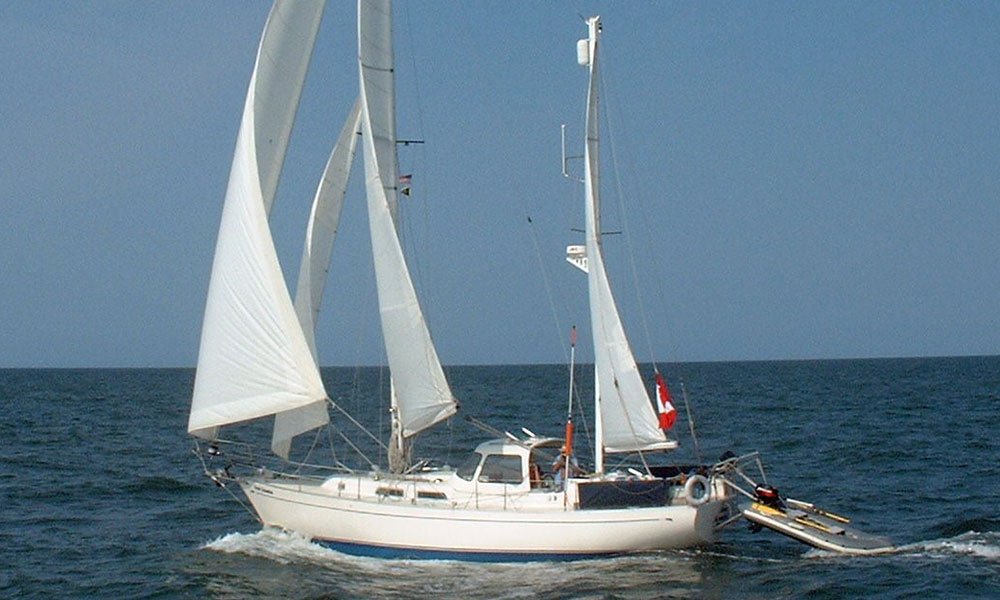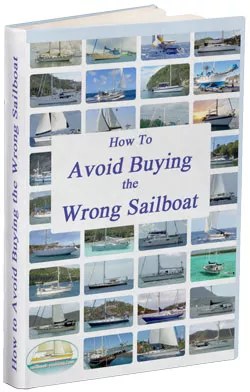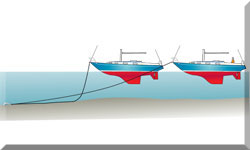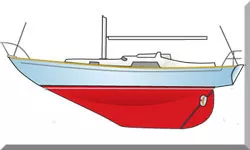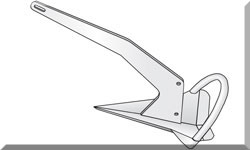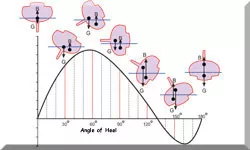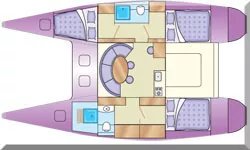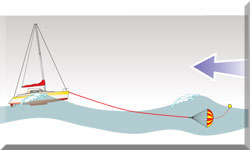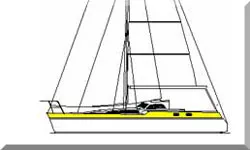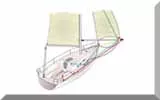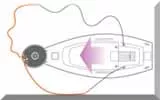- Home
- Cruising Yachts 40' to 45'
- Hughes 40
The Hughes 40 Sailboat
Specs & Key Performance Indicators
The Hughes 40, a staysail ketch, was designed by Sparkman & Stephens and built in Canada by Hughes Boatworks.
Published Specification for the Hughes 40
Underwater Profile: Fin keel with skeg-hung rudder
Hull Material: GRP
Length Overall: 41'6" (13.3m
Waterline Length: 31'6" (9.7m)
Beam: 13'4" (4.1m)
Draft: 5'0" (1.5m)
Rig Type: Staysail ketch
Displacement: 24,000lb (10,886kg)
Designer: Sparkman & Stephens
Builder: Hughes Boatworks (Canada)
Year First Built: 1975
Design Ratios
- The Sail Area/Displacement Ratio, calculated by dividing the sail area by the vessel's displacement, predicts the sailboat's speed potential. A higher ratio suggests a speedier ship. The Hughes 40, with its modest rating (16.8), suggests a balanced design that does not compromise stability for speed, making it ideal for cruising.
- The Ballast/Displacement Ratio (38.5%) for the Hughes 40 underscores its durability and stiffness under harsh sea conditions. With a high ratio, the Hughes 40 offers increased stability, an essential trait for a cruising sailboat. The strength of this sailboat not only holds up to the challenges of the sea but also offers a comforting sense of security for seafarers.
- The Displacement/Length Ratio (246) of the Hughes 40 provides insights into its seaworthiness. A lower ratio indicates a lightweight and agile vessel, while a higher ratio signifies a heavy cruiser more suited for long, open water journeys. The Hughes 40 hits a sweet spot, offering an excellent compromise between weight and performance.
- The Comfort Ratio estimates the motion comfort of the boat under various sea conditions, giving potential buyers an idea of how smooth or rough the sailboat's ride will be. The Hughes 40 features a high Comfort Ratio of 34, implying a smooth ride even in rough waves, an asset on long voyages where fatigue from constant motion can set in.
- The Capsize Screening Formula of the Hughes 40 deserves mentioning, considering it to be a significant factor determining a sailboat's seaworthiness. This figure (1.7) suggests that the Hughes 40 is relatively resistant to capsizing, ensuring peace of mind for its users.
The all-important design ratios; what they mean and how they're derived...
Down Below
The interior layout and design of the Hughes 40 sailboat focuses on practicality and efficiency for extended voyages. Here's a general description of the amenities it typically offers:
- Salon: The main salon features a spacious sitting area with comfortable sitting arrangments, which can also convert into additional berths for sleeping. This area generally accommodates a fold-down table for group meals, navigation tables, or card games.
- Galley: The galley, or kitchen, is typically designed for the economy of movement, with a stove, oven, sink, and storage for food and cooking equipment. Some models also feature a fridge and a microwave.
- Cabins: Hughes 40 usually offers two cabins – one forward and one aft. Both cabins usually have a double berth and are equipped with storage areas and hanging lockers.
- Head: The Hughes 40 offers a single marine toilet or 'head', sometimes with a separate shower area. The space is compact but designed to be easy to clean and maintain.
- Cockpit: On deck, there’s a large cockpit for navigation and outdoor living. It's designed for comfort and safety for both coastal and offshore expeditions.
Remember, each Hughes 40 sailboat might be different, as owners often modify their boats to fit their needs. These are general features and your actual layout and amenities may vary.
Alternatives & Options
Toward the later production years of the Hughes 40, some different versions and modifications were introduced to meet diverse sailors' preferences and requirements. However, details on these variants may not always be clear due to the customizations done by owners over the years.
- Hughes 40 Pilothouse: Some versions of the Hughes 40 were produced with a pilothouse layout, providing an enclosed steering station. Pilothouse boats are popular among cruisers as they combine the security of an inside steering station with the visibility of outdoor navigation.
- Interior Modifications: While the traditional Hughes 40 has a two-cabin layout, some versions might have come with a single-cabin layout that provides more open space in the salon area.
- Rigging Variations: There are some versions of Hughes 40 with cutter rigs, which involve a second, smaller headsail for more sailing versatility, particularly in harsh weather conditions.
Keep in mind that each Hughes boat is unique, regardless of the model, thanks to the company's tradition of encouraging owners to customize their boats to suit personal needs and ambitions. Therefore, it is always recommended to inspect a prospective Hughes 40 carefully to assess modifications and confirm the boat's current condition.
The Competition
The Hughes 40 is a stable and sturdy cruiser, built for long-distance voyages. However, other sailboats in its class also have unique characteristics that make them suitable for specific sailing conditions. Let's compare it with a couple of other similarly sized sailboats.
1. Hughes 40 vs. Catalina 400
- Speed: Hughes 40, with its sleek design and large sail area, tends to be faster in the right conditions. Meanwhile, the Catalina 400 is also fast but it's more reliable at moderate wind speeds.
- Comfort: The Catalina 400 has a more spacious interior, making it more suitable for extended periods of cruising.
- Durability: Hughes 40 is recognized for its robust build, designed to withstand tough weather conditions.
2. Hughes 40 vs. Beneteau 40
- Performance: The Beneteau 40 has a reputation for being more maneuverable due to its fin keel with spade rudder. Hughes 40, however, is known for its cruising stability, especially in high winds.
- Comfort: Once again, the Hughes 40 may be outclassed by the Beneteau 40, which offers a more luxurious interior and better facilities.
- Maintenance: Owners often find the Hughes 40 easier and more affordable to maintain over the long term, due to its simpler design and durable construction.
Take note that each of these sailing yachts has its pros and cons, so the best choice depends on your personal needs, preferences, and sailing conditions. For instance, if you value interior comfort and luxury over everything else, then the Catalina 400 or Beneteau 40 might be more appealing. Conversely, if you are planning long voyages and want a sea-worthy vessel that can withstand harsh weather, the Hughes 40 would be more suitable.
Possible issues...
Common issues and complaints about Hughes 40 sailboats are not widely documented due to the boat's robust and reliable construction. However, no boat is without its quirks and potential concerns. Here are some common issues that some Hughes 40 owners might express:
- Aging Systems: Given the Hughes 40s were built during the 1970s, many of the original boats will require updating of electrical wiring, plumbing, and onboard electronics. This effort can be time-consuming and may bring unanticipated expenses.
- Interior Space: While the Hughes 40 is well-known for its sailing performance and seaworthiness, some might find the interior living space to be relatively compact, particularly when compared to more modern cruising yachts in the same size bracket.
- Availability of Spare Parts: Due to the age of these boats and the closure of Hughes Boat Works, finding exact replacement parts can sometimes be a challenge.
- Deck Leaks: Like many used boats, older models may have issues with deck leaks. Potential buyers should bear this in mind during inspection and budget for any necessary repairs.
- Heavy Steering: Some owners have noted that the Hughes 40 can be noticeably heavy on the helm in certain wind conditions. This can make short-handed sailing more challenging.
- Variability in Maintenance and Condition: The Hughes 40 is a vintage boat, and the condition of individual boats on the market can vary widely, depending on how well previous owners have preserved and updated them.
Keep in mind, these issues will not apply to all Hughes 40 boats, and many owners have found them to be dependable and enjoyable cruising yachts. As with all used boat purchases, thorough research and careful inspection are key before making a decision.
The Secondhand Market
Considering the availability of Hughes 40 for sale in the secondhand market, while not overflowing, there's a decent selection available for prospective buyers. This offers an opportunity for many sailing enthusiasts to own this magnificent sailboat, often at a fraction of the price of a brand-new one.
The asking prices for secondhand Hughes 40 sailboats vary considerably, depending on the condition, age, location, and included equipment. However, generally, these boats are priced competitively when compared to other sailboats in the same class, making them an affordable choice for many.
We found several used Hughes 40 sailboats listed for sale online at prices ranging from $50,000 to $100,000.
.........................
I wrote this article using GPT-4, OpenAI’s large-scale language-generation model, as a research assistant to gather information, summarize research findings, and provide suggestions for the content and structure of the article.
Dick McClary, creator and owner of sailboat-cruising.com
.........................
Recent Articles
-
Which Type of Boat Fridge Is The Most Efficient?
Apr 24, 25 05:06 AM
The top opening boat fridge is reputed to be more efficient than the front opening type, but that may not be the case - and here, amongst other boat refrigeration considerations, is why -
Multihull Autopilot Selection is Not Straightforward
Apr 19, 25 01:25 PM
Whether its for a catamaran or a trimaran, tiller or wheel steered, a multi hull autopilot must be endowed with specific performance characteristics... -
Wheel-Steering Autopilots: Your Questions Answered...
Apr 18, 25 03:45 PM
Whatever your question, you should find the answer here
